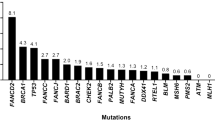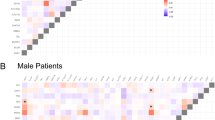Abstract
Hypomorphic germline variants in TERT, the gene encoding the reverse transcriptase component of the human telomerase complex, occur with a frequency of 3–5% in acute myeloid leukemia. We analyzed the clinical and prognostic impact of the most common TERT A1062T variant in younger patients with acute myeloid leukemia intensively treated within two prospective multicenter trials. Four hundred and twenty patients (age 17–60 years) were analyzed for the TERT A1062T variant by direct sequencing. Fifteen patients (3.6%) carried the TERT A1062T variant. Patients with the TERT A1062T variant had a trend towards less favorable and more intermediate 2/adverse karyotypes/genotypes according to the European Leukemia Net classification. In univariate and multivariate analysis, patients with the TERT A1062T variant had a significantly inferior overall survival compared to wild-type patients (6-year overall survival 20 vs. 41%, p = 0.005). Patients with the TERT A1062T variant showed a high rate of treatment-related mortality: 5/15 (33%) died during induction therapy or in complete remission as compared to 62/405 (15%) of the wild-type patients. In patients with the TERT variant, 14/15 (93%) suffered from non-hematological/non-infectious grade 3/4 adverse events (mostly hepatic and/or mucosal) as compared to 216/405 (53%) wild-type patients (p = 0.006). In multivariate analysis, the TERT A1062T variant was an independent risk factor predicting for adverse events during induction chemotherapy. In conclusion, the TERT A1062T variant is an independent negative prognostic factor in younger patients with acute myeloid leukemia and seems to predispose those patients to treatment-related toxicity.



Similar content being viewed by others
References
Löwenberg B, Downing JR, Burnett A (1999) Acute myeloid leukemia. N Engl J Med 341:1051–1062
Dohner K, Dohner H (2008) Molecular characterization of acute myeloid leukemia. Haematologica 93:976–982
Dohner H, Estey EH, Amadori S, Appelbaum FR, Buchner T, Burnett AK et al (2010) Diagnosis and management of acute myeloid leukemia in adults: recommendations from an international expert panel, on behalf of the European LeukemiaNet. Blood 115:453–474
Falini B, Mecucci C, Tiacci E, Alcalay M, Rosati R, Pasqualucci L et al (2005) Cytoplasmic nucleophosmin in acute myelogenous leukemia with a normal karyotype. N Engl J Med 352:254–266
Fröhling S, Schlenk RF, Breituck J, Benner A, Kreitmeier S, Tobis K et al (2002) Prognostic significance of activating FLT3 mutations in younger adults (16 to 60 years) with acute myeloid leukemia and normal cytogenetics: a study of the AML Study Group Ulm. Blood 100:4372–4380
Thol F, Damm F, Ludeking A, Winschel C, Wagner K, Morgan M et al (2011) Incidence and prognostic influence of DNMT3A mutations in acute myeloid leukemia. J Clin Oncol 29:2889–2896
Gaidzik VI, Schlenk RF, Moschny S, Becker A, Bullinger L, Corbacioglu A et al (2009) Prognostic impact of WT1 mutations in cytogenetically normal acute myeloid leukemia: a study of the German-Austrian AML Study Group. Blood 113:4505–4511
Frohling S, Schlenk RF, Stolze I, Bihlmayr J, Benner A, Kreitmeier S et al (2004) CEBPA mutations in younger adults with acute myeloid leukemia and normal cytogenetics: prognostic relevance and analysis of cooperating mutations. J Clin Oncol 22:624–633
Wagner K, Damm F, Gohring G, Gorlich K, Heuser M, Schafer I et al (2010) Impact of IDH1 R132 mutations and an IDH1 single nucleotide polymorphism in cytogenetically normal acute myeloid leukemia: SNP rs11554137 is an adverse prognostic factor. J Clin Oncol 28:2356–2364
Thol F, Damm F, Wagner K, Gohring G, Schlegelberger B, Hoelzer D et al (2010) Prognostic impact of IDH2 mutations in cytogenetically normal acute myeloid leukemia. Blood 116:614–616
Schlenk RF, Dohner K, Krauter J, Frohling S, Corbacioglu A, Bullinger L et al (2008) Mutations and treatment outcome in cytogenetically normal acute myeloid leukemia. N Engl J Med 358:1909–1918
Calado RT, Regal JA, Hills M, Yewdell WT, Dalmazzo LF, Zago MA et al (2009) Constitutional hypomorphic telomerase mutations in patients with acute myeloid leukemia. Proc Natl Acad Sci U S A 106:1187–1192
Allsopp RC, Vaziri H, Patterson C, Goldstein S, Younglai EV, Futcher AB et al (1992) Telomere length predicts replicative capacity of human fibroblasts. Proc Natl Acad Sci U S A 89:10114–10118
Kim NW, Piatyszek MA, Prowse KR, Harley CB, West MD, Ho PL et al (1994) Specific association of human telomerase activity with immortal cells and cancer. Science 266:2011–2015
Chiu CP, Dragowska W, Kim NW, Vaziri H, Yui J, Thomas TE et al (1996) Differential expression of telomerase activity in hematopoietic progenitors from adult human bone marrow. Stem Cells 14:239–248
Meena J, Rudolph KL, Gunes C (2015) Telomere dysfunction, chromosomal instability and cancer. Recent Results Cancer Res 200:61–79
Muraki K, Nyhan K, Han L, Murnane JP (2012) Mechanisms of telomere loss and their consequences for chromosome instability. Front Oncol 2:135
Calado RT, Young NS (2008) Telomere maintenance and human bone marrow failure. Blood 111:4446–4455
Armanios M, Blackburn EH (2012) The telomere syndromes. Nat Rev Genet 13:693–704
Aref S, El-Ghonemy MS, Abouzeid TE, El-Sabbagh AM, El-Baiomy MA (2014) Telomerase reverse transcriptase (TERT) A1062T mutation as a prognostic factor in Egyptian patients with acute myeloid leukemia (AML). Med Oncol 31:158
Heil G, Krauter J, Raghavachar A, Bergmann L, Hoelzer D, Fiedler W et al (2004) Risk-adapted induction and consolidation therapy in adults with de novo AML aged </= 60 years: results of a prospective multicenter trial. Ann Hematol 83:336–344
Krauter J, Heil G, Hoelzer D, Ottmann OG, Martin H, Lübbert M et al (2006) Treatment of patients up to 60 years with high risk AML: final results of the AML SHG-Hannover 01/99 trial. Blood 108:132a–1433
Krauter J, Peter W, Pascheberg U, Heinze B, Bergmann L, Hoelzer D et al (1998) Detection of karyotypic aberrations in acute myeloblastic leukemia: a prospective comparison between PCR/FISH and standard cytogenetics in 140 patients with de novo AML. Br J Haematol 103:72–78
Damm F, Heuser M, Morgan M, Wagner K, Gorlich K, Grosshennig A et al (2011) Integrative prognostic risk score in acute myeloid leukemia with normal karyotype. Blood 117:4561–4568
Damm F, Heuser M, Morgan M, Yun H, Göhring G, Schlegelberger B et al (2010) A single nucleotide polymorphism in the mutational hotspot of WT1 predicts a favorable outcome in cytogenetically normal acute myeloid leukemia patients. J Clin Oncol 28:578–585
Cawthon RM (2002) Telomere measurement by quantitative PCR. Nucleic Acids Res 30:e47
Korn EL (1986) Censoring distributions as a measure of follow-up in survival analysis. Stat Med 5:255–260
Calado RT, Cooper JN, Padilla-Nash HM, Sloand EM, Wu CO, Scheinberg P et al (2012) Short telomeres result in chromosomal instability in hematopoietic cells and precede malignant evolution in human aplastic anemia. Leukemia 26:700–707
Scheinberg P, Cooper JN, Sloand EM, Wu CO, Calado RT, Young NS (2010) Association of telomere length of peripheral blood leukocytes with hematopoietic relapse, malignant transformation, and survival in severe aplastic anemia. JAMA 304:1358–1364
Peffault de LR, Calado RT, Busson M, Abrams J, Adoui N, Robin M et al (2012) Age-adjusted recipient pretransplantation telomere length and treatment-related mortality after hematopoietic stem cell transplantation. Blood 120:3353–3359
Calado RT, Young NS (2009) Telomere diseases. N Engl J Med 361:2353–2365
Sznajer Y, Baumann C, David A, Journel H, Lacombe D, Perel Y et al (2003) Further delineation of the congenital form of X-linked dyskeratosis congenita (Hoyeraal-Hreidarsson syndrome). Eur J Pediatr 162:863–867
Zaug AJ, Crary SM, Jesse FM, Campbell K, Cech TR (2013) Many disease-associated variants of hTERT retain high telomerase enzymatic activity. Nucleic Acids Res 41:8969–8978
Pickett HA, Reddel RR (2015) Molecular mechanisms of activity and derepression of alternative lengthening of telomeres. Nat Struct Mol Biol 22:875–880
Chiodi I, Mondello C (2012) Telomere-independent functions of telomerase in nuclei, cytoplasm, and mitochondria. Front Oncol 2:133
Mukherjee S, Firpo EJ, Wang Y, Roberts JM (2011) Separation of telomerase functions by reverse genetics. Proc Natl Acad Sci U S A 108:E1363–E1371
Indran IR, Tufo G, Pervaiz S, Brenner C (2011) Recent advances in apoptosis, mitochondria and drug resistance in cancer cells. Biochim Biophys Acta 1807:735–745
Calado RT, Yewdell WT, Wilkerson KL, Regal JA, Kajigaya S, Stratakis CA et al (2009b) Sex hormones, acting on the TERT gene, increase telomerase activity in human primary hematopoietic cells. Blood 114:2236–2243
Le Saux CJ, Davy P, Brampton C, Ahuja SS, Fauce S, Shivshankar P et al (2013) A novel telomerase activator suppresses lung damage in a murine model of idiopathic pulmonary fibrosis. PLoS One 8:e58423
Bernardes de JB, Schneeberger K, Vera E, Tejera A, Harley CB, Blasco MA (2011) The telomerase activator TA-65 elongates short telomeres and increases health span of adult/old mice without increasing cancer incidence. Aging Cell 10:604–621
Acknowledgements
This study was supported by grant nos. DJCLS H 06/04v and H 09/01f from the Deutsche-José-Carreras Leukämie-Stiftung e.V. and grant nos. 01GI0378 (Kompetenznetz “Akute und chronische Leukämien”) and 01KG0605 from the Bundesministerium für Bildung und Forschung and the Dieter-Schlag-Stiftung. The authors would like to thank Elvira Lux, Sylvia Horter, Diana Dudacy, Monika Bischoff, and Patricia Hanel for their excellent technical support.
Author contribution
A.B., J.K., and K.W. designed the research. A.B., J.K., F.D., F.T., M.H., and K.W. performed research and analyzed data. G.G. and B.S. performed the cytogenetic studies. O.O., M.L., M.W., L.K., G.S., A.R., W.F., H.K., W.B., G.H., and A.G. contributed patient samples and clinical data. A.B., J.K., A.G., and K.W. wrote the paper. All authors read and agreed to the final version of the manuscript.
Author information
Authors and Affiliations
Corresponding author
Ethics declarations
Conflict of interest
The authors declare that they have no conflict of interest.
Additional information
Katharina Wagner and Arnold Ganser contributed equally to this work.
Electronic supplementary material
Supplementary Table 1
(PDF 32 kb)
Rights and permissions
About this article
Cite this article
Both, A., Krauter, J., Damm, F. et al. The hypomorphic TERT A1062T variant is associated with increased treatment-related toxicity in acute myeloid leukemia. Ann Hematol 96, 895–904 (2017). https://doi.org/10.1007/s00277-017-2967-0
Received:
Accepted:
Published:
Issue Date:
DOI: https://doi.org/10.1007/s00277-017-2967-0




